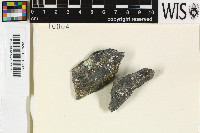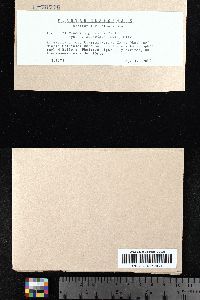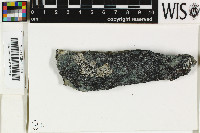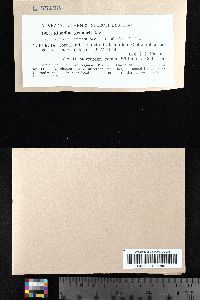
- Home
- Search
- Images
- Species Checklists
- US States: O-Z >
- US National Parks
- Central America
- South America
- US National Parks
- Southern Subpolar Region
|
|
|
|
Family: Physciaceae
[Buellia alocizoides (Leight.) A.L. Sm., moreCaloplaca subexigua (Nyl.) H. Olivier, Lecanora exigua f. demissa (Körb.) Stizenb., Lecanora exigua var. demissa (Körb.) Stizenb., Lecanora subexigua Nyl., Lecidea alocizoides Leight., Rinodina confragosa var. demissa (Körb.) Kremp., Rinodina demissa (Körb.) Arnold, Rinodina demissa f. demissa (Flörke) Arnold, Rinodina demissa f. microcarpa Erichsen, Rinodina demissa f. obscura (Malbr.) H. Olivier, Rinodina exigua f. demissa (Körb.) Zahlbr., Rinodina exigua var. demissa (Flörke) Th. Fr., Rinodina metabolica var. demissa Körb., Rinodina salina Degel., Rinodina salina f. microcarpa (Erichsen) Erichsen, Rinodina salina f. obscura (Malbr.) Erichsen, Rinodina salina f. salina Degel., Rinodina salina f. subrufescens (Nyl.) Erichsen, Rinodina sophodes var. demissa (Körb.) Rostrup, Rinodina subexigua (Nyl.) H. Olivier, Zeora metabolica var. demissa Flörke] |
MB#404343 Type. ITALY. Liguria, Mte. Faiallo nell' Apennino di Voltri, s.d. F. Baglietto s.n. (MOD - lectotype, Mayrhofer & Moberg 2002). Rinodina salina Degel., Ark. F. Bot. 30: 55 (1940). R. salina Degel. Uppsala Univ. Arsskr. 1939 (11): 192 nomen inval. Sine descript. Lat. Rinodina demissa auct. non R. demissa (Flotow) Arnold. Exsiccatae. Hepp Flechten Eur. 645 (NY as R. demissa). Description. Thallus thin or inconspicuous, dark grey to grey-brown, rimose or often areolate; areoles discrete, scabrid, or well developed and contiguous, to 0.20-0.70 mm wide; surface plane or verrucose, matt; margin determinate or indeterminate; prothallus sometimes present, fimbriate, dark brown; vegetative propagules absent. Apothecia broadly attached, frequent and sometimes contiguous, to 0.25-0.60(-0.80) mm in diam.; disc black, plane, sometimes becoming markedly convex; thalline margin concolourous with thallus, 0.05-0.10 mm wide, entire becoming excluded; excipular ring absent. Apothecial Anatomy. Thalline exciple 20-100 µm wide laterally; cortex 5-10 µm wide; epinecral layer sometimes present, 5-10 µm thick; crystals absent from cortex and medulla; cortical cells to 4.5-7.5 µm wide, pigmented or not; algal cells to 8.5-14.5 µm long; thalline exciple 30-100 µm deep below; cortex 10-15 µm; proper exciple 5-20 µm wide laterally, expanded to 20-30(-55) µm at periphery; hypothecium hyaline, 30-70 µm deep; hymenium 70-90 µm high, not inspersed; paraphyses 1.5-2.5 µm wide, not conglutinate, with apices expanded to 4.0-6.5 µm wide, darkly pigmented, forming a dark brown epihymenium; asci 40-60 x 12-19 µm. Ascospores 8/ascus, Type A or B development, Dirinaria-type, (11.5-)14.0-15.0(-17.5) x (6.0-)7.5-8.5(-9.5) µm, average l/b ratio 1.7-1.9, apical walls not or hardly thickened at maturity, narrowly swollen at septum in large spores, some spores swelling at septum in KOH; torus absent; walls lightly ornamented or not. Pycnidia immersed in thallus; conidia bacilliform, 4.0-6.0 x ca. 1.0 µm (Trinkhaus et al. 1999). Chemistry. Spot tests all negative; secondary metabolites not detected. Substrate and Ecology. Frequent on maritime rocks wherever suitable substrate occurs as the species is able to tolerate periodic immersion in saltwater from wave splash. Rinodina gennarii is also found on wood in the same environment (mostly piers). Also on eutrophic rocks used as bird perches in coastal regions. Fertile apothecia have been recorded on minute thalli (3.5-5.0 mm in diam.), 2.5 years old or less, growing on a painted whale skeleton in the grounds of the Santa Barbara Museum of Natural History (Bratt personal communication). This suggests that the species may be a relatively aggressive colonizer of new substrates. Distribution. Widely distributed on maritime rocks in temperate regions of the northern and southern hemispheres, more rarely on calcareous substrates inland in Europe (Trinkhaus et al. 1999, Kaschik 2006 as R. oleae). Not recorded outside coastal regions in North America. Notes. Rinodina gennarii is characterized by its relatively small, Dirinaria-type spores, primarily saxicolous habitat and coastal distribution. It is remarkable for the degree of variability shown by its thallus morphology and spore size. The thallus, which may be inconspicuous, is usually continuous or rimose with a scabrid appearance, but may also be well developed with verrucose areoles. The thallus may also vary in colour from light grey to grey-brown, such colour variation being seen within a single thallus on different exposures. The Type B spore development, typical of Dirinaria-type spores (Mayrhofer and Moberg 2002), is often difficult to find. The general habit of R. gennarii may be similar to that of R. innata and R. pacifica which possess larger Physcia- and Physconia-type spores, respectively, each with a prominent pigmented torus at maturity. Rinodina innata, which has been collected with R. gennarii above the spray zone, is otherwise distinguished by its innate apothecia. Rinodina pacifica has larger apothecia and a brown thallus. Rinodina gennarii is closely related to the corticolous R. oleae as discussed under that species. Specimens examined. CANADA. BRITISH COLUMBIA. Blue Point, W.J. Noble 3234; Callishaw Point, W.J. Noble 2812; East Sooke Park, W.J. Noble 4257; Gabriola Island, W.J. Noble 2906a, 3024; Gravelly Bay, W.J. Noble 2603; Halfmoon Bay, W.J. Noble 3465b (all UBC); Haida Gwaii (Queen Charlotte Islands), Howe Bay, I.M. Brodo 17459; Masset Inlet, I.M. Brodo 18331a; Rennell Sound, I.M. Brodo 10325; Skidegate Landing, I.M. Brodo 11731; Skidegate Inlet, I.M. Brodo 11150 (all CANL); Hornby Island, T.E. Weier 1463 (COLO); Jordan Point, W.J. Noble 4448 (UBC); Mayne Island, W.J. Noble 1769 (SASK); Montague Prov. Park, W.J. Noble 913A; Mount Newton, W.J. Noble 3914b (both UBC); N Sechelt, I.M. Brodo 8367 (CANL); Nanaimo, I.M. Brodo 8081 (CANL, COLO); Narvdez Bay, W.J. Noble 1557; 16 km S Parksville, W.J. Noble 4994; Saanich Inlet, W.J. Noble 3791a, 3797a; Saltspring Island, W.J. Noble 2295 (all UBC); C.D. Bird 19188 (WIS); I.M. Brodo 13914 (CANL); Swartz Head, W.J. Noble 3981; Thieves Bay, W.J. Noble 500b; Yeo Point, W.J. Noble 2305b (all UBC). NEW BRUNSWICK. Dalhousie, 1930, T. Reijonen (H). NEWFOUNDLAND & LABRADOR. 1897, A.C. Waghorne; Big Island, 1897, A.C. Waghorne; Coal River, 1897, A.C. Waghorne (all MICH); A.C. Waghorne 331 (BM, MIN); Riverhead, A.C. Waghorne 422 (MIN). NOVA SCOTIA. Sable Island, D.H.S. Richardson 192a, 193a (NSPM). QUEBEC. La Côte-de-Gaspé Co., Forillon Nat. Park, I.M. Brodo 18624,18625 (CANL). MEXICO. BAJA CALIFORNIA NORTE. Guadalupe Island, C.M. Wetmore 75754 (MIN). U.S.A. CALIFORNIA. Alameda Co., Sunol Regional Park, 1968, R. Russo (UC); Los Angeles Co., Catalina Island, 1993, J.W. Sheard 5037a (SASK); Griffith Park, 1906, H.E. Hasse (ABSL); Rustic Canyon, 1895, H.E. Hasse (NY); Santa Monica, H.E. Hasse (FH, MU); Santa Monica Mountains, 1902, H.E. Hasse (H); Marin Co., St. Hilary's Church, 1965, A. Howard; Tomales Hamlet, 1945, V.M. Miller (both UC); Mendocino Co., 12 mi N Fort Bragg, T.H. Nash 11427 (ASU); Glass Beach, S.C. Tucker 35188 (SBBG); Albion, T.H. Nash 11434 (ASU); Westport, I. Tavares 518 (UC); 2.2 mi S Westport, W.P. Jordan 4234 (SASK); Merces Co., Pacheco Pass, S.C. Tucker 28822 (SBBG); Monterey Co., Pacific Grove, P. van den Boom 29329 (personal herb.); Orange Co., Weir Canyon, K. Knudsen 6135 (UCR); San Luis Obispo Co., Avila Beach, S.C. Tucker 34221a (SBBG); Cambria, I. Tavares 1406a (UC); Montana de Oro station, P. van den Boom 28989 (personal herb.); Morro Rock Reserve, R.E. Reifner 93‑7 (WIS); San Carpoforo Creek, K. Knudsen 6476 (UCR); San Simeon Beach, S.C. Tucker 36517 (ASU); San Mateo Co., Jasper Ridge Biological Reserve, S.C. Tucker 36375 (SBBG); Santa Barbara Co., Mission Canyon, C.C. Bratt 9141 (SASK); Montecito, S.C. Tucker 34424, 34426 (SBBG); Sal Ridge, P. van den Boom 29559 (personal herb.); Santa Barbara Botanical Garden, S.C. Tucker 36466 (SBBG); Santa Cruz Island, T.H. Nash 32274 (ASU); Santa Rosa Island, J.W. Sheard 5057a, 5070c, 5102f (SASK); C.M. Wetmore 73615 (MIN); Sonoma Co., Goat Rock, S.C. Tucker 37821 (SBBG); MAINE. Cumberland Co., Brunswick, 1939, G. Degelius (US); Cape Elizabeth, 1913, G.K. Merrill (FH); Hancock Co., Little Moose Island, T.J. Sullivan 2737b, 2735 (MIN); Knox Co., Warren, 1912, G.K. Merrill (FH); Washington Co., Milbridge, E. Lay 92-0381 (personal herb.); S Jonesport, I.M. Brodo 30722 (CANL). MASSACHUSETTS. Bristol Co., Dartmouth, 1884, H. Willey; Westport Point, 1889, H. Willey (both US); Middlesex Co., Cambridge, E. Tuckerman (FH); 2000, E. Lay; Norfolk Co., Moon Island, E. Lay 02‑193 (both personal herb.); Weymouth, H. Willey (US); Plymouth Co., Onset, Cape Cod, E. Lay 95‑1600; Bumpkin Island, E. Lay 02‑190; Peddocks Island, E. Lay 90‑0234; Suffolk Co., Calf Island, E. Lay 01‑578; Georges Island, E. Lay 01‑580; Long Island, E. Lay 01‑592; Middle Brewster, E. Lay 02‑203 (all personal herb.). NEW YORK. Suffolk Co., Orient Point, I.M. Brodo 2828a (MSC). OREGON. Douglas Co., 3 km S Tenmile, B. McCune 23841 (personal herb.); Lincoln Co., Newport, B. McCune 23908 (personal herb.); S Seal Rock State Park., B. McCune 27285 (personal herb.); Seal Rock, C.M. Wetmore 24654 (MIN). WASHINGTON. Clallam Co., Crescent Beach, T.H. Nash 2411 (ASU); Elwa, I.M. Brodo 15319 (CANL); San Juan Co., Blakely Island, B. Fink 428 (MICH); Juan, Waldron Island, B. Fink 356 (MICH, MU); Whatcom Co., S Wildcat Cove, B.D. Ryan 2889 (SASK). Selected References. Brodo (1968 as R. salina), Mayrhofer & Poelt (1979 Abb.12b), Noble (1982), Mayrhofer (1984a Abb. 2h), Fox & Purvis (1992), Matzer & Mayrhofer (1996 Fig. 1F), Trinkhaus et al. (1999 Figs. 1-5), Giralt (2001 Plate XII: B), Mayrhofer & Moberg (2002 p. 43, 103), Sheard (2004), Kaschik (2006 Fig. 50 as R. oleae) Nash, T.H., Ryan, B.D., Gries, C., Bungartz, F., (eds.) 2004. Lichen Flora of the Greater Sonoran Desert Region. Vol 2. Thallus: crustose, thin or evanescent, rimose but often with discrete, scabrid areoles, or areoles well developed, plane or verrucose, up to 0.2-0.7 mm wide surface: dark gray to gray-brown, dull; margin: determinate or indeterminate; prothallus: sometimes present, fimbriate, dark brown; vegetative propagules: absent Apothecia: adnate, frequent and sometimes contiguous, up to 0.25-0.6(-0.8) mm in diam. disc: black, plane, sometimes becoming markedly convex thalline margin: concolorous with thallus, 0.05-0.1 mm wide, entire becoming excluded; excipular ring: absent thalline exciple: 20-100 µm wide laterally; cortex 5-10 µm wide; sometimes with epinecral layer: 5-10 µm thick; cortical cells: up to 4.5-7.5 µm wide, pigmented or not; algal cells: up to 8.5-14.5 µm in diam.; thalline exciple: 30-100 µm thick below; cortex 10-15 µm proper exciple: 5-20 µm wide laterally, expanded to 20-30(-55) µm at periphery hymenium: 70-90 µm tall, paraphyses: 1.5-2.5 µm wide, not conglutinate, with apices expanded up to 4-6.5 µm wide, darkly pigmented, forming a dark brown epihymenium; hypothecium: hyaline, 30-70 µm thick asci: clavate, 40-60 x 12-19 µm, 8spored ascospores: brown, 1-septate, broadly ellipsoid, type B development, Dirinaria-type, (11.5-)14-15(-17.5) x (6-)7.5-8.5(-9.5) µm, apical walls not or hardly thickened at maturity, narrowly swollen at septum in large spores, some spores swelling at septum in K; torus: absent; walls: lightly ornamented or not Pycnidia: immersed in thallus conidia: bacilliform, 4-6 x c. 1 µm Spot tests: all negative Secondary metabolites: none detected. Substrate and ecology: frequent on maritime rocks and on eutrophic rocks used as bird perches in coastal regions World distribution: widely distributed on maritime rocks in temperate regions of the Northern and Southern Hemispheres, more rarely on calcareous substrates inland in Europe Sonoran distribution: Channel Islands, coastal California and Guadalupe Island, Baja California. Notes: Rinodina gennarii is remarkable for the degree of variability shown by its thallus morphology and spore size. The thallus, that may be evanescent, is usually continuous or rimose with a scabrid appearance, but may also be well developed with verrucose areoles. The thallus may also vary in color from light gray to gray-brown, such color variation being seen within a single thallus on different exposures. Its habit may be similar to that of R. innata and R. pacifica that possess larger Physcia-, and Physconia-type spores, respectively, each with a prominent pigmented torus at maturity. Rinodina innata, that has been collected with R. gennarii above the spray zone, is otherwise distinguished by its innate apothecia. Rinodina pacifica has larger apothecia and a brown thallus. |










































